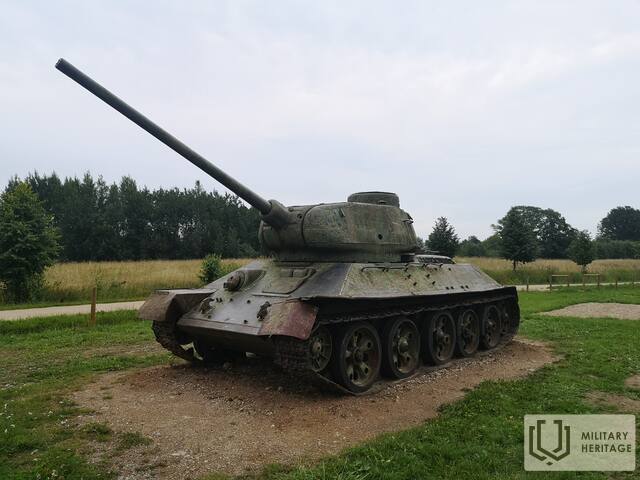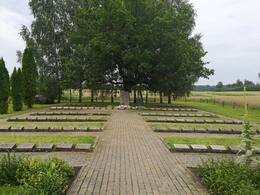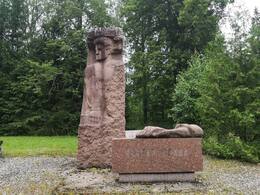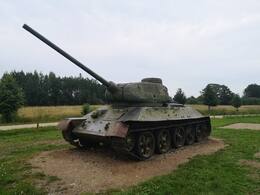The Battles of More
The Battle of More was one of the fiercest battles on the territory of Latvia during World War II. In it, the 19th Division of the Latvian Legion repelled the Red Army's attempts to break through to Riga, which allowed the withdrawal of German forces from Estonia. The battle lasted from September 25 to October 6, 1944. The legionnaires, in heroic battles, repelled a tenfold superior Red Army force.
In the autumn of 1944, the Red Army had occupied all of Latgale, concentrated its troops on the Lubāna side and formed a spearhead of the attack towards the Gulf of Riga with the aim of cutting off the parts of the German Army Group Nord, which were located in Southern Estonia, as well as cutting off the 16th Army. The Red Army was opposed by the German 18th Army, including the 19th Division of the Latvian Legion, initially at Lake Lubāna, then retreating in the battles of Barkava, Aiviekste and Ranka, until reaching More through Vecpiebalga, Drusti, Sērmūkšiei, Skujeni and Nītauri.
On September 25, 1944, the 19th Division occupied the Sigulda defense positions built in Mores parish. Heavy fighting took place for five days. Nine Red Army battalions were sent to two company-protected positions in the center of Mores, the attacks were supported by artillery, aviation and tanks. The legionnaires destroyed 4 tanks with anti-tank guns. Due to the lack of artillery shells, the Latvian legionnaires had to defend their positions for two days in continuous and extremely heavy close combat.
On September 28, the Red Army managed to break through the legionnaires' positions near Kārtuži. The next day, with the support of six German assault guns, the breach was eliminated in a counterattack. Many Red Army soldiers and their regiment commander fell. The attacks in the following days became weaker and on September 30, the Battle of More was over. The Latvian legionnaires had fulfilled their mission on their own land - the enemy was stopped. On the night of October 5-6, by order, the 19th Division left the Sigulda defensive positions and on October 6, the Red Army with reinforcements occupied the empty More trenches.
The number of Latvian soldiers killed was about 200, wounded about 650, while the Red Army lost about 2,700 killed and 10,000 wounded, five T-34 tanks were destroyed and one IL-2 bomber was shot down. The Battle of More is a vivid example of the courage and heroism of the Latvian soldier, proven for centuries.
More information sources
1. Website of the Mores Battle Museum. Available: http://www.moresmuzejs.lv/index.php?nod=21 [accessed 08.05.2021.].
2. National Armed Forces website. Available: https://www.mil.lv/lv/latvijas-neatkaribas-kars [accessed 08.05.2021.].
Related timeline
Related objects
Mores Battle Memorial Park
The park was created in the former battle place in the Centre of More Parish where during the first two weeks of 1944 in the Second World War, major battles were held, holding thestrategically created defence line and preventing the Red Army from breaking through to Riga, thus affecting the further course of history.
You can see fragments of wartime relics and bunker sites here. A commemorative stone created by the sculptor H. Sprincis, as well as a Memorial Plaque with 186 soldiers names carved into the granite, are located in the Battles of More Memorial Park.
Red Army Brethren Cemetery in More
The Red Army Military Cemetery is located on the side of the main road through More. It is the final resting place for approximately 2000 soldiers who were killed during the Battle of More. In 1974 the cemetery was landscaped and a monument by sculptor B. Grīsle was unveiled.
Museum of Battles in More
The museum is located in More, on the side of the V319 motorway. It is dedicated to the Battles of More between the Red Army and the Latvian Legion of the German Army in the autumn of 1944. The exhibit includes a mock-up of the battlefield, weapons, awards, soldiers’ uniforms and military equipment. The Battles of More Museum and Memorial Park was established by former soldiers of the Latvian Legion who participated in the Battles of More. The memorial park features trenches, dugouts and battlefields. The battles in the More area were only part of a large-scale operation of the Red Army Baltic Offensive involving a total of 900,000 soldiers and large numbers of military equipment units. A part of the German Army fortification system where Latvian legionnaires prevented the Red Army’s attempt to break out to Riga was located in the vicinity of More. This allowed the German Army to withdraw its forces from Estonia and avoid defeat. Red Army leaders expected the enemy’s resistance near More to be short-lived and stubbornly continued its unprepared and uncoordinated attacks, suffering heavy losses. Local advantages and the combat capabilities of the Latvian legionnaires played a significant role in the subsequent course of the war. More is home to the Latvian Legionnaires’ Brothers’ Cemetery and a Red Army Soldiers’ Cemetery.
Related stories
Unrecognized Soldiers. The Story of a Combat Officer.
The Battle of More is an episode of the final stage of World War II, which had a great importance in the further course of the war in the territory of Latvia. The Battle of More refers to the hostilities that took place from September 25 to October 5, 1944, on the Sigulda Defense Line in the territory of More parish. In the trenches of the Sigulda Defense Line, approximately 12 km long, soldiers of the 19th Division of the Latvian Legion, fighting heavy battles with a 10 to 15-fold superiority of the enemy for 10 days, stopped the advance of the Red / Soviet Army units towards Riga.








